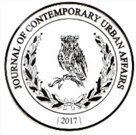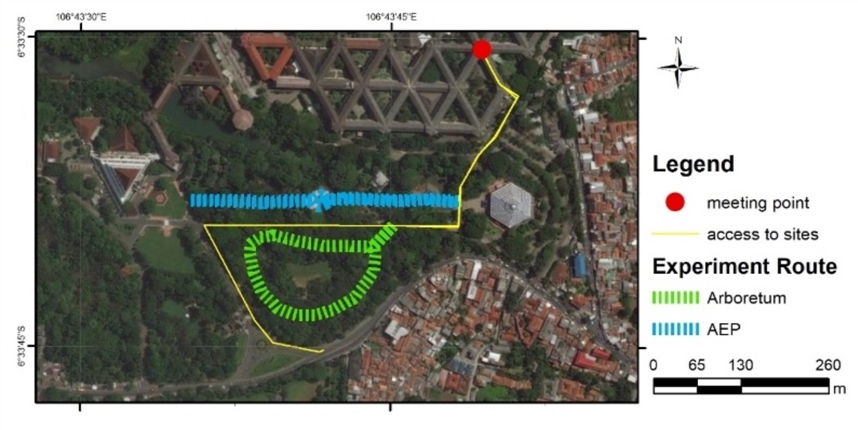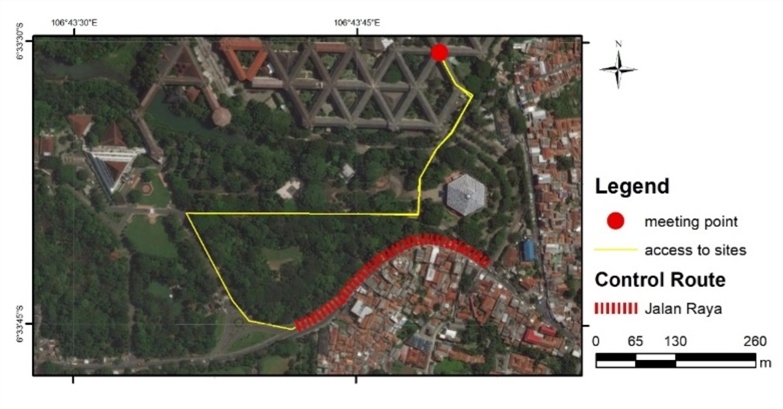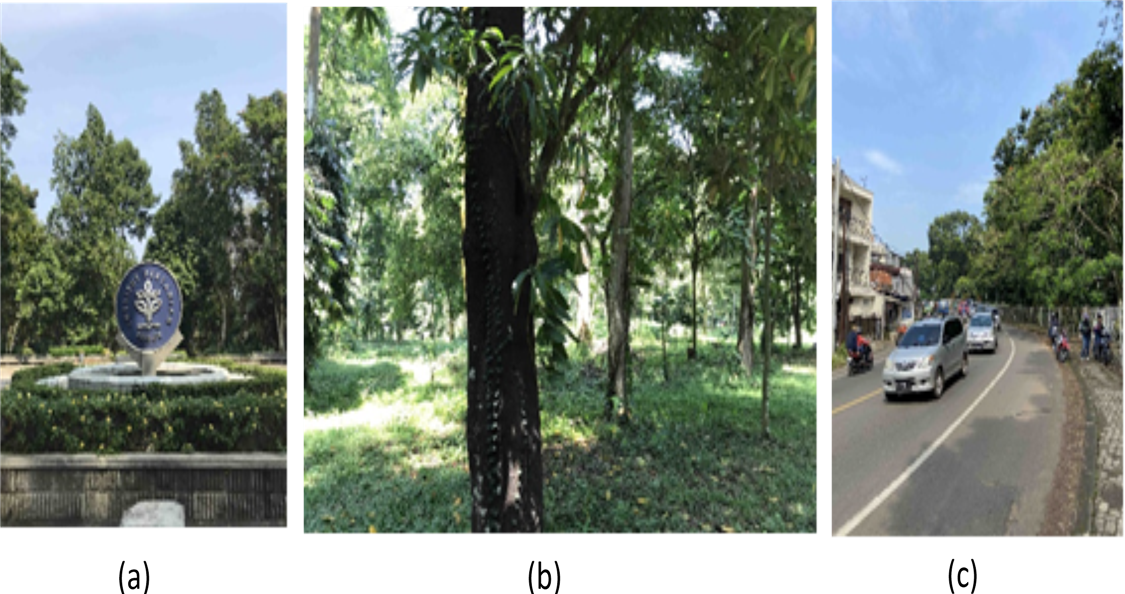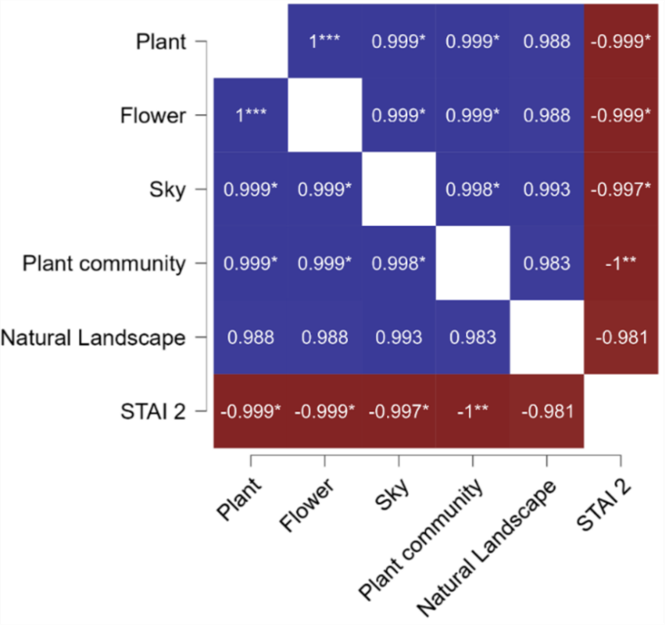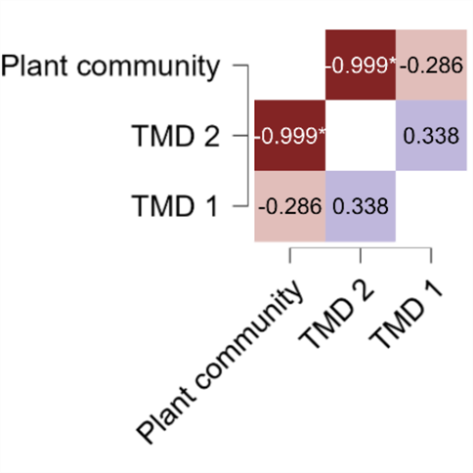
Figure 6. Heat Map Correlation of Total Mood Disturbance and Landscape Elements of Park Therapy.
4. Discussions
The environment becomes the main stimulus that can give the effect of wanting to move and have an activity (refuge and prospect) or move away (escape). Green space is an inseparable part of an academic landscape where students can interact, learn, observe, and research. A campus landscape with vista, spaces and appropriate design can form students' good behaviour and nature awareness of the surrounding landscape, grow a sense of pride in their university and lead to their satisfaction and academic motivation (Ghorbanzadeh, 2019). The previous studies showed that the type of natural green space could affect the psychological response of students. The type of landscape affects the decrease in psychological responses, especially negative moods such as "depression-dejection" and "tension-anxiety" detected in the arboretum. It was in line with Gatersleben & Andrews (2013) that an arboretum might have a high prospect (clear vision) and a low refuge (place to hide) so that it becomes a restorative natural green space. Walking in the campus park and arboretum affected decreased almost all negative moods, including "confusion-bewilderment", "depression-dejection", "tension-anxiety", and "fatigue-inertia" as well as anxiety status. The previous studies also exhibited significant differences in moods and state anxiety after walking in urban parks (Lyu et al., 2019; Song et al., 2013, 2014, 2015, 2019). Furthermore, parks have positive psychological effects by offering recreational aims for users with mental disorders (Tok et al., 2020).
4.1 Consistency of landscape elements correlation among the three locations
Based on the correlation analysis, it was discovered that the preference for landscape elements was consistent in the three locations. The two highest labels detected by the three locations were “plant” and “sky”. It shows that the openness of views to the sky (high prospect) and the plants along the walking course were mostly chosen by young adults. Gatersleben & Andrews (2013) proved that natural landscapes with high prospects and low refuge created restorative places. Moreover, the AEP with an artificial landscape (plaza) and its feature also provide high prospects and low refuge, which establishes potential benefits of psychological restoration (Subiza-pérez et al., 2020). Plant and the sky are natural landscape elements providing pleasurable experiences through the human senses and significantly affect tension, confusion, and depression (Wang et al., 2019). Plant strongly influences human perceptions, preferences, and physiological and psychological effects because the organs of plants, from the roots to the flowers, can produce and release BVOCs that humans can perceive via their five senses (Loreto et al., 2014). Thus, practising forest bathing in space with high prospects and low refuge by integrating stimulation of the five senses in the natural landscape leads to beneficial psychological and physiological effects (Antonelli et al., 2020).
4.2 Restorative Park Therapy Components
The therapeutic landscape element cannot be seen in landscape photographs while walking on the courses. The correlation between image labels and the psychological effects after walking was explored further. It was found that anxiety levels were negatively related to landscape elements. The only landscape element, plant community, was negatively correlated with Total Mood Disturbance. While, plant community, plant, flower, and sky were correlated with a state of anxiety. The more these elements were detected by Google API, the lower the mood disturbance and state of anxiety. Campus green space was considered among the most preferred feature by students, showing the significance of creating alternative campus habitats for students (Bostancı & Akdağ, 2020). Greenery and flowers, as natural stimuli, become prominent seasonal landscape elements that correlate with physiological and psychological responses, such as a reduction in diastolic blood pressure and an increase in vigor after walking in urban parks (Pratiwi et al., 2020). This study proved a correlation between landscape preference in different sites. Moreover, park therapy components, including plant, flower, and sky, were negatively correlated with negative moods and anxiety levels. Thus, the hypothesis of this research (namely, that preferred landscape elements would correlate with decreased psychological responses of negative moods and state anxiety) was supported.
5. Conclusions
The prevalence of mental health problems has doubled among young adults due to the COVID-19 pandemic. Many studies have proved physiological and psychological of taking the atmosphere in a forest landscape, namely Shinrin-yoku. Still, they lack study regarding the relation between landscape preference and the psychological effects of Shinrin-yoku. The eminence of image annotation using Google API is effective and has potential in formulating park therapy components. Park therapy components, including plant, flower, and sky, were negatively correlated with negative moods and anxiety levels. The campus green space with high visibility to the sky view, proper planting design, and fascinating landscape elements can potentially overcome psychological disturbances for the academic community. Therefore, managing tree canopy management regularly, proposing a compact and mass planting design, and selecting flowering landscape plants are needed to get optimal psychological relaxation results.
Future research should seek to discover therapeutic campus greenspace design criteria based on academic community preference. Physical, social, symbolic, and experienced spaces in the campus landscape must be integrated into campus greenspace planning to encourage thorough health restoration in the academic campus landscape.
Funding
The research was funded by Community Fund, Research and Community Service IPB University under the Rector's Decree of 2022 Number: 68/IT3/PN/2021 dated May 31 2021.
Conflicts of interest
The Author(s) declares(s) that there is no conflict of interest.
Data availability statement
The original contributions presented in the study are included in the article, further inquiries can be directed to the corresponding author/s.
Ethics statements
No potentially identifiable human images or data are presented in this study.
CRediT author statement
Conceptualization: P.I.P., B.S. Data curation: P.I.P., S.S., S.N.L. Formal analysis: P.I.P., S.S., S.N.L. Funding acquisition: P.I.P., B.S. Investigation: P.I.P., S.S. Methodology: P.I.P. Project administration: P.I.P., B.S., S.S., S.N.L. Writing—original draft: P.I.P., S.S., S.N.L. Writing—review and editing: P.I.P., B.S., S.S., S.N.L. All authors have read and agreed to the published version of the manuscript.
References
Antonelli, M., Donelli, D., Barbieri, G., Valussi, M., Maggini, V., & Firenzuoli, F. (2020). Forest volatile organic compounds and their effects on human health: A state-of-the-art review. International Journal of Environmental Research and Public Health, 17(18), 1–36. https://doi.org/10.3390/ijerph17186506
Asian Development Bank (2022). Rising from the pandemic. ADB. https://doi.org/http://dx.doi.org/10.22617/TCS220093-2
Amen, M. (2022). The effects of buildings’ physical characteristics on urban network centrality. Ain Shams Engineering Journal, 13(6), 101765. https://doi.org/10.1016/j.asej.2022.101765
Amen, M., & Nia, H. A. (2018). The dichotomy of society and urban space configuration in producing the semiotic structure of the modernism urban fabric. Semiotica, 2018(222), 203–223. https://doi.org/10.1515/sem-2016-0141
Benzina, N., Morgieve, M., Euvrard, M., Flores Alves Dos Santos, J., Pelissolo, A., & Mallet, L. (2020). Personalised 360° video exposure therapy for the treatment of obsessive-compulsive disorder: A single case study. French Journal of Psychiatry, 1(2020), 31–38. https://doi.org/10.1016/j.fjpsy.2020.02.004
Bostancı, S., & Akdağ, S. G. (2020). Understanding aesthetic experiences of architectural students in vertical and horizontal campuses. Journal of Contemporary Urban Affairs, 4(2), 13–26. https://doi.org/10.25034/ijcua.2020.v4n2-2
Dutta, A., Verma, Y., & Jawahar, C. V. (2018). Automatic image annotation: the quirks and what works. Multimedia Tools and Applications, 77(24), 31991–32011. https://doi.org/10.1007/s11042-018-6247-3
Eckbo, G. (1964). Urban Landscape Design. New York: McGraw-Hill.
Elsadek, M., Liu, B., & Lian, Z. & Xie, J. (2019). Green façades: Their contribution to stress recovery and well-being in high-density cities. Urban Forestry and Urban Greening, 46(2019), 126446. https://doi.org/10.1016/j.ufug.2019.126446
Fernández-Blázquez, M. A., Ávila-Villanueva, M., López-Pina, J. A., Zea-Sevilla, M. A., & Frades-Payo, B. (2015). Psychometric properties of a new short version of the State-Trait Anxiety Inventory (STAI) for the assessment of anxiety in the elderly. Neurología, 30(6), 352–358. https://doi.org/10.1016/j.nrleng.2015.05.002
Foellmer, J., Kistemann, T., & Anthonj, C. (2021). Academic greenspace and well-being — can campus landscape be therapeutic? evidence from a german university. Wellbeing, Space and Society, 2(1), 100003. https://doi.org/10.1016/j.wss.2020.100003
Gao, T., Zhang, T., Zhu, L., Gao, Y., & Qiu, L. (2019). Exploring psychophysiological restoration and individual preference in the different environments based on virtual reality. International Journal of Environmental Research and Public Health, 16(17), 3102. https://doi.org/10.3390/ijerph16173102
Gatersleben, B., & Andrews, M. (2013). When walking in nature is not restorative-The role of prospect and refuge. Health and Place, 20(2013), 91–101. https://doi.org/10.1016/j.healthplace.2013.01.001
Ghorbanzadeh, M. (2019). A Study on the quality of campus landscape on students' attendance at the university campus. Civil Engineering Journal, 5(4), 950–962. https://doi.org/10.28991/cej-2019-03091302
Guo, L. N., Zhao, R. L., Ren, A. H., Niu, L. X., & Zhang, Y. L. (2020). Stress recovery of campus street trees as visual stimuli on graduate students in autumn. International Journal of Environmental Research and Public Health, 17(1), 148. https://doi.org/10.3390/ijerph17010148
Hadi, A. A., Mizuuchi, Y., Honjo, T., & Furuya, K. (2017). Identifying impressive landscape objects based on geotagged photographs (a case study of self-portraits and ordinary photographs). Journal of Indonesian Tourism and Development Studies, 5(2), 73–80. https://doi.org/10.21776/ub.jitode.2017.005.02.02
Hadi, A. A., Mizuuchi, Y., Setyanti, D., Honjo, T., & Furuya, K. (2018). Identifying visitor preferences for locations and features in bogor botanical garden, indonesia, using gps tracking and geotagged photographs. Journal of Architecture&ENVIRONMENT, 16(1), 047. https://doi.org/10.12962/j2355262x.v16i1.a3029
Hassan, A., Tao, J., Li, G., Jiang, M., Aii, L., Zhihui, J., Zongfang, L., & Qibing, C. (2018). Effects of walking in bamboo forest and city environments on brainwave activity in young adults. Evidence-Based Complement ary and Alternative Medicine, 2018(9653857), 1–9. https://doi.org/10.1155/2018/9653857
Holt, E. W., Lombard, Q. K., Best, N., Smiley-Smith, S., & Quinn, J. E. (2019). Active and passive use of green space, health, and well-being amongst university students. International Journal of Environmental Research and Public Health, 16(3), 424. https://doi.org/10.3390/ijerph16030424
Jo, H., Song, C., & Miyazaki, Y. (2019). Physiological benefits of viewing nature: A systematic review of indoor experiments. International Journal of Environmental Research and Public Health, 16(23), 4739. https://doi.org/10.3390/ijerph16234739
Julian, L. J. (2011). Measures of anxiety: state-trait anxiety inventory (STAI), beck anxiety inventory (BAI), and hospital anxiety and depression scale-anxiety (HADS-A). Arthritis Care & Research, 63(S11), S467–S472. https://doi.org/10.1002/acr.20561
Konuma, H., Hirose, H., & Yokoyama, K. (2015). Relationship of the japanese translation of the profile of mood states second edition (POMS 2®) to the first edition (POMS®). Juntendo Medical Journal, 61(5), 517–519. https://doi.org/10.14789/jmj.61.517
Kuzevanov, V. (2013, November). Botanic gardens and arboreta as ecological resources for sustainable development. Paper presented at International Symposium "Role of the Arboretum and Botanical Garden against Climate Change of the East Asia". Abstract retrieved from http://iskna.org/
Lee, J., Park, B. J., Tsunetsugu, Y., Kagawa, T., & Miyazaki, Y. (2009). Restorative effects of viewing real forest landscapes, based on a comparison with urban landscapes. Scandinavian Journal of Forest Research, 24(3), 227–234. https://doi.org/10.1080/02827580902903341
Lee, J., Park, B., Ohira, T., & Kagawa, T. (2015). Acute effects of exposure to a traditional rural environment on urban dwellers : a crossover field study in terraced farmland. International Journal of Environmental Research and Public Health, 12(2), 1874–1893. https://doi.org/10.3390/ijerph120201874
Li, K., Zhai, Y., Dou, L., & Liu, J. (2021). A preliminary exploration of landscape preferences based on naturalness and visual openness for college students with different moods. Frontiers in Psychology, 12(1), 629650. https://doi.org/10.3389/fpsyg.2021.629650
Lin, S., Hsiao, Y.-Y., & Wang, M. (2014). Test Review: The profile of mood states 2nd edition. Journal of Psychoeducational Assessment, 32(3), 273–277. https://doi.org/10.1177/0734282913505995
Loreto, F., Dicke, M., Schnitzler, J. P., & Turlings, T. C. J. (2014). Plant volatiles and the environment. Plant, Cell and Environment, 37(8), 1905–1908. https://doi.org/10.1111/pce.12369
Luo, S., Shi, J., Lu, T., & Furuya, K. (2022). Sit down and rest: use of virtual reality to evaluate preferences and mental restoration in urban park pavilions. Landscape and Urban Planning, 220(1), 104336. https://doi.org/10.1016/j.landurbplan.2021.104336
Lyu, B., Zeng, C., Deng, S., Liu, S., Jiang, M., Li, N., Wei, L., Yu, Y., & Chen, Q. (2019). Bamboo forest therapy contributes to the regulation of psychological responses. Journal of Forest Research, 24(1), 61–70. https://doi.org/10.1080/13416979.2018.1538492
Ochiai, H., Ikei, H., Song, C., Kobayashi, M., & Takamatsu, A., Miura, T., Kagawa, T., Li, Q., Kumeda, S., Imai, M., & Miyazaki, Y. (2015). Physiological and psychological effects of forest therapy on middle-aged males with high-normal blood pressure. International Journal of Environmental Research and Public Health, 12 (3), 2532–2542. https://doi.org/10.3390/ijerph120302532
OECD (2021). Supporting young people’s mental health through the COVID-19 crisis. Tackling Coronavirus (COVID-19), May, 1–15. https://doi.org/10.18356/9789210057790c003
Oku, H., & Fukamachi, K. (2006). The differences in scenic perception of forest visitors through their attributes and recreational activity. Landscape and Urban Planning, 75(1–2), 34–42. https://doi.org/10.1016/j.landurbplan.2004.10.008
Park, B. J., Furuya, K., Kasetani, T., Takayama, N., Kagawa, T., & Miyazaki, Y. (2011). Relationship between psychological responses and physical environments in forest settings. Landscape and Urban Planning, 102(1), 24–32. https://doi.org/10.1016/j.landurbplan.2011.03.005
Park, B. J., Tsunetsugu, Y., Kasetani, T., Kagawa, T., & Miyazaki, Y. (2010). The physiological effects of Shinrin-yoku (taking in the forest atmosphere or forest bathing): Evidence from field experiments in 24 forests across Japan. Environmental Health and Preventive Medicine, 15(1), 18–26. https://doi.org/10.1007/s12199-009-0086-9
Park, B. J., Tsunetsugu, Y., Kasetani, T., Morikawa, T., Kagawa, T., & Miyazaki, Y. (2009). Physiological effects of forest recreation in a young conifer forest in Hinokage Town, Japan. Silva Fennica, 43(2), 291–301. https://doi.org/10.14214/sf.213
Park, B., Tsunetsugu, Y., Kasetani, T., Hirano, H., Kagawa, T., Sato, M., & Miyazaki, Y. (2007). Physiological effects of Shinrin-yoku (taking in the atmosphere of the forest)—using salivary cortisol and cerebral activity as indicators. Journal of PHYSIOLOGICAL ANTHROPOLOGY, 26(2), 123–128. https://doi.org/10.2114/jpa2.26.123
Pratiwi, P. I., & Furuya, K. (2019). The neighbourhood park preferences and its factors among elderly residents in Tokiwadaira, Japan. Asian Journal of Behavioural Studies, 4(16), 64–79. https://doi.org/10.21834/ajbes.v4i16.178
Pratiwi, P. I., Furuya, K., & Sulistyantara, B. (2014). The difference in people’s response toward natural landscape between university students of Japan and Indonesia. Jurnal Manusia Dan Lingkungan, 21(2), 247–253. https://doi.org/10.22146/jml.18550
Pratiwi, P. I., Kim, M., & Furuya, K. (2020). Difference in Perception of Urban Green Spaces between Danchi and Apartment Residents in Tokiwadaira, Matsudo City, Japan. Jurnal Manusia Dan Lingkungan, 26(2), 80–90. https://doi.org/10.22146/jml.35608
Pratiwi, P. I., Sulistyantara, B. (2021, December). Manfaat Kesehatan Park Therapy di Kampus IPB Dramaga. Paper presented at Seminar Nasional Penelitian IPB. Abstract retrieved from https://lppm.ipb.ac.id/seminar-nasional-2021/
Pratiwi, P. I., Xiang, Q., & Furuya, K. (2019). Physiological and psychological effects of viewing urban parks in different seasons in adults. International Journal of Environmental Research and Public Health, 16(21), 4279. https://doi.org/10.3390/ijerph16214279
Pratiwi, P. I., Xiang, Q., & Furuya, K. (2020). Physiological and psychological effects of walking in urban parks and its imagery in different seasons in middle-aged and older adults: evidence from Matsudo City, Japan. Sustainability, 12(10), 4003. https://doi.org/10.3390/su12104003
Raviola G., Naslund J.A., Smith S.L., Vikram, P. (2019). Innovative models in mental health delivery systems: Task sharing care with non-specialist providers to close the mental health treatment gap. Current Psychiatry Reports, 21(6), 44. https://doi.org/10.1007/s11920-019-1028-x
Richards, D. R., Tunçer, B., & Tunçer, B. (2018). Using image recognition to automate assessment of cultural ecosystem services from social media photographs. Ecosystem Services, 31(2018), 318–325. https://doi.org/10.1016/j.ecoser.2017.09.004
Satria, A., Hidayat, A., & Abdul Haris, A. H. (2021). IPB university's policy of biodiversity's innovation for eco-edutourism. Journal of Sustainability Perspectives, 1(2), 103–107. https://doi.org/10.14710/jsp.2021.11748
Seitz, C. M., Reese, R. F., Strack, R. W., Frantz, S., & West, B. (2014). Identifying and improving green spaces on a college campus: a photovoice study. Ecopsychology, 6(2), 98–108. https://doi.org/10.1089/eco.2013.0103
Shi, J. (2020). New Methods for Landscape Assessment with Eye-Level Photography: Automated Landscape Classification, View Factors, and Virtual Reality (Publication No. 109369) [Doctoral dissertation, Chiba University]. Chiba University Repository.
Simonds J.O., Starke, B.W. (2013). Landscape Architecture: A Manual of Environmental Planning and Design. New York: Mc-Graw Hill.
Song, C., Ikei, H., Igarashi, M., Miwa, M., Takagaki, M., & Miyazaki, Y. (2014). Physiological and psychological responses of young males during spring-time walks in urban parks. Journal of Physiological Anthropology, 33(1), 8. https://doi.org/10.1186/1880-6805-33-8
Song, C., Ikei, H., Igarashi, M., Takagaki, M., & Miyazaki, Y. (2015). Physiological and psychological effects of a walk in urban parks in fall. International Journal of Environmental Research and Public Health, 12(11), 14216–14228. https://doi.org/10.3390/ijerph121114216
Song, C., Ikei, H., Kagawa, T., & Miyazaki, Y. (2019). Effects of walking in a forest on young women. International Journal of Environmental Research and Public Health, 16(2), 9–13. https://doi.org/10.3390/ijerph16020229
Song, C., Ikei, H., Kobayashi, M., Miura, T., Li, Q., Kagawa, T., Kumeda, S., Imai, M., & Miyazaki, Y. (2017). Effects of viewing forest landscape on middle-aged hypertensive men. Urban Forestry and Urban Greening, 21(2017), 247–252. https://doi.org/10.1016/j.ufug.2016.12.010
Song, C., Joung, D., Ikei, H., Igarashi, M., Aga, M., Park, B. J., Miwa, M., Takagaki, M., & Miyazaki, Y. (2013). Physiological and psychological effects of walking on young males in urban parks in winter. Journal of Physiological Anthropology, 32(1), 18. https://doi.org/10.1186/1880-6805-32-18
Subiza-pérez, M., Vozmediano, L., & San, C. (2020). Welcome to your plaza : assessing the restorative potential of urban squares through survey and objective evaluation methods. Cities, 100(1), 102461. https://doi.org/10.1016/j.cities.2019.102461
Sunarti, E., Fithriyah, A. F., Khoiriyah, N., Novyanti, W., Islamia, I., & Hasanah, V. R. (2022). Portrait of Indonesian family during one year the COVID-19 pandemic: analysis of factors influencing family welfare and resilience. Journal of Disaster Research, 17(1), 31–42. https://doi.org/10.20965/jdr.2022.p0031
Takayama, N., Saito, H., Fujiwara, A., & Horiuchi, M. (2017). The effect of slight thinning of managed coniferous forest on landscape appreciation and psychological restoration. Progress in Earth and Planetary Science, 4(1), 17. https://doi.org/10.1186/s40645-017-0129-6
Tok, E., Agdas, M. G., Ozkok, M. K., & Kuru, A. (2020). Socio-psychological effects of urban green areas: case of Kirklareli city center. Journal of Contemporary Urban Affairs, 4(1), 47–60. https://doi.org/10.25034/ijcua.2020.v4n1-5
Tsunetsugu, Y., Park, B. J., Ishii, H., Hirano, H., Kagawa, T., & Miyazaki, Y. (2007). Physiological effects of Shinrin-yoku (taking in the atmosphere of the forest) in an old-growth broadleaf forest in Yamagata Prefecture, Japan. Journal of Physiological Anthropology, 26(2), 135–142. https://doi.org/10.2114/jpa2.26.135
Urech, P. R. W., Dissegna, M. A., Girot, C., & Grêt-Regamey, A. (2020). Point cloud modeling as a bridge between landscape design and planning. Landscape and Urban Planning, 203(1), 103903. https://doi.org/10.1016/j.landurbplan.2020.103903
Völker, S., & Kistemann, T. (2015). Developing the urban blue: Comparative health responses to blue and green urban open spaces in Germany. Health and Place, 35(1), 196–205. https://doi.org/10.1016/j.healthplace.2014.10.015
Wang, X., Shi, Y., Zhang, B., & Chiang, Y. (2019). The influence of forest resting environments on stress using virtual reality. International Journal of Environmental Research and Public Health, 16(18), 3263. https://doi.org/10.3390/ijerph16183263
Włodarczyk-Marciniak, R., Sikorska, D., & Krauze, K. (2020). Residents’ awareness of the role of informal green spaces in a post-industrial city, with a focus on regulating services and urban adaptation potential. Sustainable Cities and Society, 59(1), 102236. https://doi.org/10.1016/j.scs.2020.102236
*Corresponding Author:
Department of Landscape Architecture, Faculty of Agriculture, IPB University, Indonesia
Email address: pritaindahpratiwi@apps.ipb.ac.id

